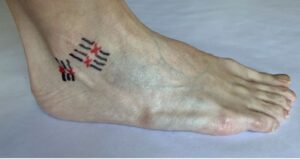Ankle Sprains & Chronic Ankle Instability Treated in Arlington, VA
 Ankle sprains are very common—approximately two million occur each year in the United States! A complex hinge joint, the ankle is formed by three bones: the tibia and fibula in the lower leg and the talus in the foot. These bones are connected and stabilized by strong bands of fibrous tissue (ligaments). An ankle sprain occurs when one of these ligaments is overstretched or torn.
Ankle sprains are very common—approximately two million occur each year in the United States! A complex hinge joint, the ankle is formed by three bones: the tibia and fibula in the lower leg and the talus in the foot. These bones are connected and stabilized by strong bands of fibrous tissue (ligaments). An ankle sprain occurs when one of these ligaments is overstretched or torn.
Most ankle sprains occur when the outer side of the joint is forcefully bent toward the ground. This common injury can happen during sports or exercise, or simply while walking on an uneven surface. Many people experience immediate pain and swelling, and possibly an inability to support weight on the affected ankle.
Ankle sprains can vary widely in severity, and proper treatment is essential to ensure complete healing. Incomplete healing can lead to chronic ankle instability, which can cause the ankle to repeatedly “give way” on its outer side.
How Is an Ankle Sprain Treated?
For all ankle sprains, it is important to follow RICE guidelines, which include:
- Resting the ankle by keeping weight off it (consider wearing an ankle brace or walking boot to limit movement)
- Icing the ankle (use crushed ice in a Ziploc bag) for 20-30 minutes at a time to decrease painful swelling
- Compressing the ankle with an ACE wrap bandage or elastic ankle sleeve to further reduce swelling
- Elevating the ankle above heart level during the first 24-48 hours to help excess fluid drain away from the injury site
Additionally, over-the-counter nonsteroidal anti-inflammatory drugs (NSAIDs) can be taken as needed.
A minor ankle sprain may heal with a few days of self-care. However, if the injured ankle is very swollen, bruised, stiff, painful to walk on or cannot support any bodyweight, it is important to seek professional medical attention. Many ankle sprains have associated injuries—such as tendon tears, cartilage damage, scar tissue build-up and hairline fractures—that do not improve without treatment.
See an Ankle Specialist in Arlington
Dr. Matthew Buchanan is a board-certified, fellowship-trained orthopedic foot and ankle surgeon who practices at Nirschl Orthopaedic Center in Arlington, Virginia, and has been treating ankle sprains for more than 15 years. A sports enthusiast and avid cyclist, Dr. Buchanan also understands the importance of a quick recovery. His goal is to provide each patient with a strong, confidence-inspiring, pain-free ankle that allows them to enjoy life to its fullest.
If you suspect that you have sprained your ankle, Dr. Buchanan can evaluate your injury and order X-rays to determine if a fracture is present. Once he confirms your diagnosis, he can suggest an appropriate treatment plan to promote healing and help prevent complications, such as chronic ankle instability and arthritis.
To facilitate a gradual return to activity, Dr. Buchanan may recommend a rehabilitation program to help restore ankle strength, flexibility, and range of motion. To address an ankle sprain that does not improve with conservative treatment, he may suggest surgery, such as ankle arthroscopy to remove scar tissue and loose bone fragments and repair or reconstruct torn ligaments and tendons. Dr. Buchanan performs many procedures on an outpatient basis using the latest minimally invasive techniques.
If you would like to schedule a visit with Dr. Buchanan in Arlington, VA, to discuss your ankle sprain or chronic ankle instability, call Nirschl Orthopaedic Center at 703-525-2200 today.
